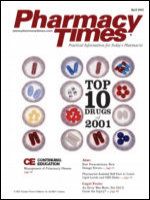Publication
Article
Pharmacy Times
Elidel (Pimecrolimus Cream 1%)
Author(s):
IntroductionThe skin is an important organ that protects the body against invasion of organisms and prevents internal organ injury. Yet 17% of the U.S. population is affected by eczema (also known as dermatitis), a common, unpleasant skin disorder. Eczema is most commonly encountered by physicians in the primary care setting. Common signs and symptoms include erythema, edema, thickening of epidermal layers, and excessive keratin production. In dermatitis, the initial inflammatory response can be directed at exogenous or endogenous stimuli. Atopic dermatitis is a form of eczema that is associated with an endogenous inflammatory response. Conventional therapies are mostly ineffective and/or associated with significant adverse drug reactions. Pimecrolimus (Elidel Cream 1%, Novartis Pharmaceuticals, East Hanover, NJ) recently was approved by the FDA for the treatment of mild-to-moderate atopic dermatitis in patients 2 years of age and older. Pimecrolimus is a nonsteroidal drug approved for this indication. (1,2)
Pharmacology
Derived from ascomycin, the active ingredient of pimecrolimus is a natural substance produced by the fungus Streptomyces hygroscopicus var. Pimecrolimus is a potent inhibitor of calcium-dependent calcineurin enzymes. It binds to FK binding protein and blocks dephosphorylation of calcineurin. Therefore, pimecrolimus inhibits cellular activity of inter-leukin-2, -4, and -10, and other important proinflammatory cytokines. These inflammatory cytokines are directly or indirectly involved in itching, edema, erythema, and skin injuries.(3,4)
Clinical StudiesIn three major clinical trials, the safety and efficacy of pimecrolimus were evaluated for the treatment of mild-to-moderate atopic dermatitis in patients 3 to 17 years of age. Patients were randomized to pimecrolimus cream 1% or vehicle-controlled creams. In the majority of patients, dermatitis was affecting the face and neck area. At 6 weeks, 57% of the pimecrolimus-treated patients reported a significant improvement in pruri-tis symptoms compared with 34% of the vehicle-treated patients. In most patients, a significant effect was observed by day 15.
Adverse Drug ReactionsDuring clinical trials, pimecrolimus was well tolerated. No major skin irritation, contact sensitization, photosensitivity, or photo allergy were reported. Only 4% of patients reported skin reaction and site burning. Pimecrolimus should be discontinued in the case of skin burning, and should not be applied to areas with active viral infections. In addition, the safety and efficacy of pimecrolimus in the treatment of infectious dermatitis have not been evaluated in clinical studies.(4)
OutlookApproximately 40 million Ameri-cans suffer from eczema. Pimecrolimus is an effective topical agent and may improve some of the symptoms of mild-to-moderate atopic dermatitis. Pimecrolimus is an excellent alternative to glucocorticoids in patients with atopic dermatitis.
A thin layer of pimecrolimus should be applied twice daily for as long as symptoms of atopic dermatitis persist. Pimecrolimus will be available in tubes of 15, 30, and 100 g. (4,5)
For a list of references, send a stamped, self-addressed envelope to: References Department, Attn. E. McCardell, Pharmacy Times, 241 Forsgate Drive, Jamesburg, NJ 08831; or send an e-mail request to: emccardell@pharmacytimes.com.







